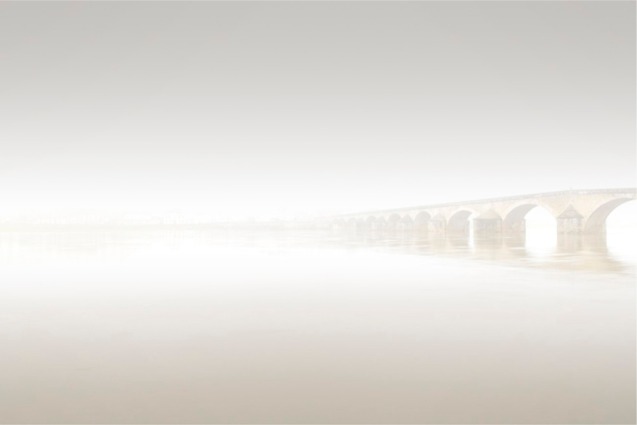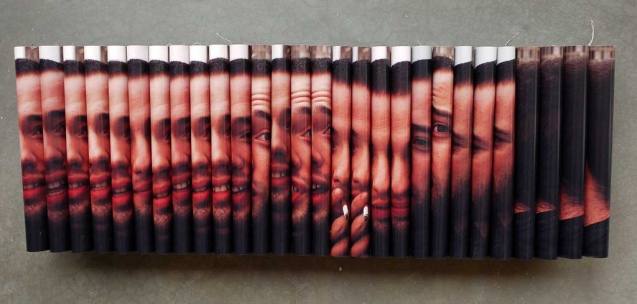I started my research looking at landscape photographers. Evaluating my Dartmoor pictures, I wanted to explore photographers in the more minimalist genre. Specifically I have been looking at pictures by Michael Kenna(1), Michael Levin(2), Darren Moore(3) and Per Bak Jensen(4). I also returned to look at photographs by Fay Godwin (5).
In an interview Michael Kenna says of his work which he describes as ‘sparse’, “so there’s lots of room for an individual, the viewer, to enter into the rectangle, like going onto a stage to recite their own lines and create their own story’. (6)
To me long exposure minimalist fine art photography is a transformation in itself, as what you see is what the photographer has decided to create an interpretation of the scene which is often highly selective, which a focus on space, light, form and composition. For example the photograph below, Loire Valley by Michael Levin.
I have also returned to a series of photographs that I admired last year but didn’t have time to document on my blog, these were the photographs by Bill Brandt in the last chapter of his book Perspective of Nudes (1961). Bill Brandt wrote in his article, “A Statement on Photography” Camera in London, 1948 (7) ‘I felt that I understood what Orson Welles meant when he said ‘the camera is much more than a recording apparatus. It is a medium via which messages reach us from another world’. For over fifteen years I was now preoccupied with photographing nudes. I learned very much from my old Kodak. It taught me how to use acute distortion to convey the weight of a body or the lightness of a movement. …..These last pictures are close-ups of parts of the body, photographed in the open air, I saw knees and elbows, legs and fists as rocks and pebbles which blended with cliffs and became an imaginary landscape.’
For me these are transformations of the body within an environment to create a new landscape.
What I like about these is how the body becomes part of the landscape, is the landscape forming more shapes within the frame, like living Henry Moore sculptures.
This led me back to also look at the photographs of Arno-rafael-minkkinen (8), that I researched in my Postcode project in Level 2 see Bushy Park – Sunrise
Today I have been reviewing portraiture transformations. I had looked for Jenny Saville(9) as I was familiar with her pictures of exaggerated bodies, In doing so I came across this picture The Passage. Jenny Saville comments, ‘With the transvestite I was searching for a body that was between genders. I had explored that idea a little in Matrix. The idea of floating gender that is not fixed. The transvestite I worked with has a natural penis and false silicone breasts. Thirty or forty years ago this body couldn’t have existed and I was looking for a kind of contemporary architecture of the body. I wanted to paint a visual passage through gender – a sort of gender landscape.’

This picture fell in line with thoughts I had around transgender as a theme for the project. Earlier I had thought about Drag as well as an interesting subject.
In looking at portraiture transformation I have come across the work of Lucas Simões, a Brazilian artist. A brief synopsis in Wikipedia states, ‘Lucas Simões’ work is highly influenced by his architectural and design background. Over the years Simões has experimented working with a wide range of materials: maps, books, photographs, concrete, silicon, wax and paper. The artist processes the materials in different ways: burning, cutting, layering, reshaping, diluting or distorting them.’ (10)
I am attracted by the decoupage techniques of works such as the one below:

I thought the following work really interesting, especially thinking about our work on Time Lapse this term, Lucas Simons states, ‘In cinema, for example, I am very fond of films by Andrey Tarkovsky and Wim Wenders because of the way they move the camera within the scenery, the continuity of the scenes, the simplicity of the images.
In my work, I use personal photos to create a movement much like that of cinema. They are photos that represent a frame from a film. Each photo is often revealed by merely moving the image within the photo a few millimeters. They are woven in the form a wave and then fixed onto a support made of wood and cloth.
The aligned and woven photos give the sensation of movement. They are my own reference to the cinema, without being cinema, hence the name “quasi-cinema.” ‘
These images are sewed folded photographs on fabric and wood.



This research is leading me to think about producing a piece of work that is on transgender but possibly as a decoupage or installation, showing man to woman and woman to man in the shape of a landscape, showing transgender as just a continuum of one person.
To start this process off I am going to experiment with a time-lapse of me applying my makeup. If I find that I can’t execute the idea I have I think that the techniques I am thinking of could serve for representing other personal journeys. My working title for this project is ‘Personal journeys’
Assessment Criteria: 1,3
References
- 1)http://www.michaelkenna.net/index2.php
- 2) http://www.michaellevin.ca
- 3) http://www.darrenmoorephotography.com
- 3)http://www.aestheticamagazine.com/near-and-far-landscape-photography-per-bak-jensen/
- 4)http://www.faygodwin.com
- 7)http://www.americansuburbx.com/2011/04/bill-brandt-statement-on-photography.html
- 8) http://www.arno-rafael-minkkinen.com
- 9) http://www.saatchigallery.com/artists/artpages/jenny_saville
- 10) https://en.wikipedia.org/wiki/Lucas_Simões
- 11) http://www.lucassimoes.com.br/quase-cinema
Further reading:
- ezine , Slices of Silence, conversations about photography http://nlwirth.com/blog
- http://www.michaelkenna.com/store/
- http://www.beetlesandhuxley.com/artists/michael-kenna-born-1953.html?page=7
- http://www.michaellevin.ca
- https://500px.com/joeltjintjelaar
- https://www.theguardian.com/artanddesign/2011/jan/08/margaret-drabble-fay-godwin
- http://www.dreamideamachine.com/en/?p=11250
- https://www.theguardian.com/artanddesign/2016/apr/25/jenny-saville-painter-artist-gagosian-gallery-london-interview-charles-saatchi-yba
- http://www.redefinemag.com/2013/lucas-simoes-photographer-interview-desretratos-series/
- http://twistedsifter.com/2011/02/lucas-simoes-art/



Great and fascinating post. Interesting research.
LikeLiked by 1 person
Thanks, although I hadn’t managed to get something down on paper, have been researching, procrastinating and reflecting in the silence!!!
LikeLiked by 1 person
Pingback: Realisations | Photos and other stuff